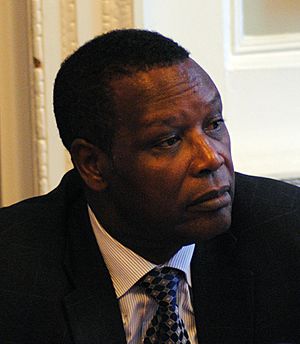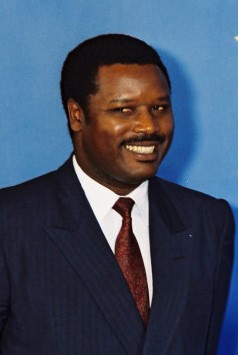Pierre Buyoya facts for kids
Quick facts for kids
Pierre Buyoya
|
|
|---|---|

Buyoya, pictured at Chatham House in 2013
|
|
| 3rd President of Burundi | |
| In office 25 July 1996 – 30 April 2003 Acting: 25 July 1996 – 11 June 1998 |
|
| Prime Minister | Pascal-Firmin Ndimira |
| Vice President |
See list
|
| Preceded by | Sylvestre Ntibantunganya |
| Succeeded by | Domitien Ndayizeye |
| In office 9 September 1987 – 10 July 1993 |
|
| Prime Minister | Adrien Sibomana |
| Preceded by | Jean-Baptiste Bagaza |
| Succeeded by | Melchior Ndadaye |
| Personal details | |
| Born | 24 November 1949 Rutovu, Ruanda-Urundi (modern-day Burundi) |
| Died | 17 December 2020 (aged 71) Bonneuil-en-France, France |
| Resting place | Bamako |
| Political party | UPRONA |
| Spouse | Sophie Buyoya |
| Alma mater | Royal Military Academy |
| Military service | |
| Allegiance | |
Pierre Buyoya (born November 24, 1949 – died December 17, 2020) was a military officer and politician from Burundi. He served as the President of Burundi two times. His first term was from 1987 to 1993, and his second was from 1996 to 2003. He was the second-longest serving president in Burundi's history.
Buyoya was from the Tutsi ethnic group. He joined the only legal political party at the time, called UPRONA. He quickly moved up in the Burundian military. In 1987, he led a military takeover that removed President Jean-Baptiste Bagaza from power. This allowed Buyoya to become president. During his first time in office, there were serious conflicts between different ethnic groups in 1988. After these events, Buyoya set up a National Reconciliation Commission. This group helped create a new constitution in 1992. The new constitution allowed for many political parties and a government that did not favor one ethnic group.
In the 1993 Burundian presidential election, Buyoya ran for president but lost to Melchior Ndadaye. Ndadaye was from the Hutu ethnic group and the FRODEBU party. Just three months after Ndadaye became president, he was killed during an attempted military takeover. This event led to more violence and started the Burundian Civil War.
During the civil war, Buyoya returned to power in another military takeover in 1996. In his second time as president, he worked to create a government that included people from different ethnic groups. He partnered with the FRODEBU party. This led to the Arusha Accords in 2000. These agreements helped share power among ethnic groups and paved the way for the end of the civil war. Buyoya chose Domitien Ndayizeye, a Hutu, as his vice-president. Ndayizeye became president in 2003, and the civil war officially ended two years later.
After the war, Buyoya became a senator for life because he was a former head of state. He also worked as an African Union envoy, helping with peace missions in countries like Chad and Mali. In November 2020, a court in Burundi linked him to the 1993 events that led to Ndadaye's death. He died of COVID-19 two months later.
Contents
Early Life and Military Career
Pierre Buyoya was born on November 24, 1949, in Rutovu, which was then part of Belgian-controlled Ruanda-Urundi. Today, Rutovu is in Bururi Province, Burundi. His father, Rurikumunwa, was from the Tutsi ethnic group.
Pierre went to a Catholic school in Rutovu from 1958 to 1963. He then attended another school until 1967. After that, he joined the Burundian Army as an officer. He studied at the Royal Military Academy in Brussels, Belgium. He rose to the rank of major.
Buyoya also studied social sciences. He continued his military training in France from 1976 to 1977. Later, he studied in West Germany from 1980 to 1982.
In 1978, Buyoya married Sophie Ntaraka, and they had four children. He joined the Union for National Progress (UPRONA) party and became part of its Central Committee in 1979. In 1982, he joined the General Staff of the Army, where he was in charge of training. Because he moved up the military ranks so quickly, people sometimes called him "Old Man." His fellow soldiers respected him.
Presidency
First Term: 1987–1993
In September 1987, Pierre Buyoya led a military takeover. This action removed President Jean-Baptiste Bagaza from power. Bagaza himself had taken power in a takeover in 1976.
After the takeover, Buyoya became the leader of a military committee. He announced plans to improve the country's economy. Like previous leaders, he led a government mostly made up of Tutsi people. This led to a Hutu uprising in August 1988, which caused many deaths. After these events, Buyoya created a Commission of National Reconciliation.
On September 9, he was officially named President of Burundi. In early October, he formed a new government with both civilian and military members. He also became the Minister of National Defence.
This commission helped create a new constitution, which Buyoya approved in 1992. This constitution aimed for a government that did not favor any one ethnic group. It also called for a president and a parliament. Democratic elections were held in June 1993. Melchior Ndadaye, a Hutu, won the election. He then formed a government that included both Hutu and Tutsi members.
However, in October 1993, Ndadaye was killed during an attempted military takeover. This event led to a long period of civil war in Burundi. Many people were killed and displaced during this conflict. There were several attempts to form a stable government, but the fighting continued.
Second Term: 1996–2003
On July 25, 1996, Pierre Buyoya returned to power in another military takeover. He had strong support from the army. He removed the interim President, Sylvestre Ntibantunganya, who had struggled to stop the violence.
The civil war became less intense, but it did not fully stop. Other countries placed economic restrictions on Burundi because of how Buyoya returned to power. However, these restrictions were eased as Buyoya worked to create a government that included different ethnic groups.
In June 1998, he formed a new "partnership" with the National Assembly. This assembly was mostly made up of members from the Hutu-backed Front for Democracy in Burundi (FRODEBU). This partnership helped lead to the Arusha Accords in 2000. These agreements introduced a way for different ethnic groups to share power. This paved the way for the end of the Civil War.
Buyoya chose Domitien Ndayizeye, a Hutu, as his vice-president. The Arusha Accords required Buyoya to hand over power in 2003, which he did. Ndayizeye became the President of Burundi on April 30, 2003. The civil war finally ended in 2005.
Later Activities
After the Civil War, Buyoya became a senator for life. This was allowed for former heads of state under the 2004 constitution.
In 2008, the African Union asked Pierre Buyoya to lead a peace mission in Chad. He was later appointed to another peace mission in Mali.
In October 2020, a court in Burundi linked Buyoya to the 1993 events that led to President Ndadaye's death.
In December 2020, he became sick with COVID-19 in Mali. He was first hospitalized in Bamako but was later moved to France. He died on December 17, 2020, in Bonneuil-en-France, while on his way to a hospital in Paris. He was buried in Bamako on December 29, 2020.
See also
 In Spanish: Pierre Buyoya para niños
In Spanish: Pierre Buyoya para niños


